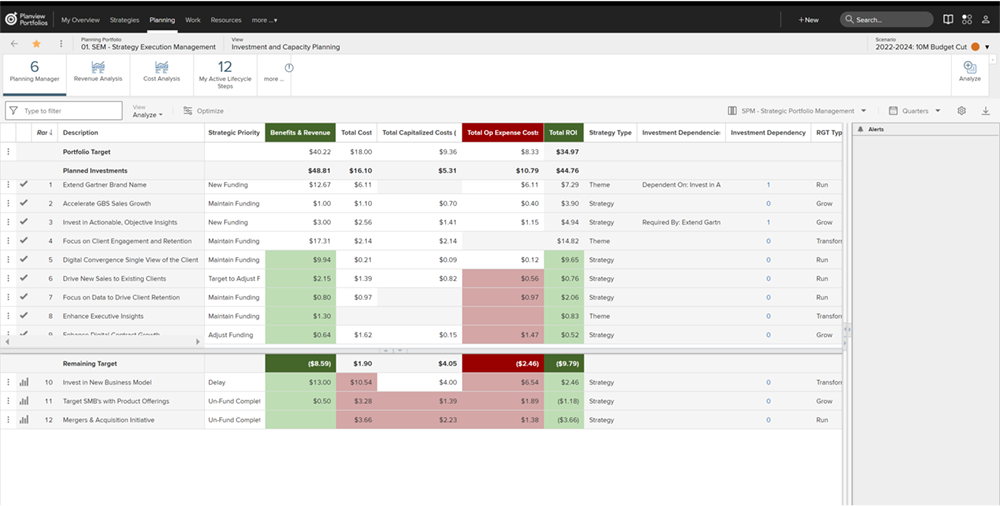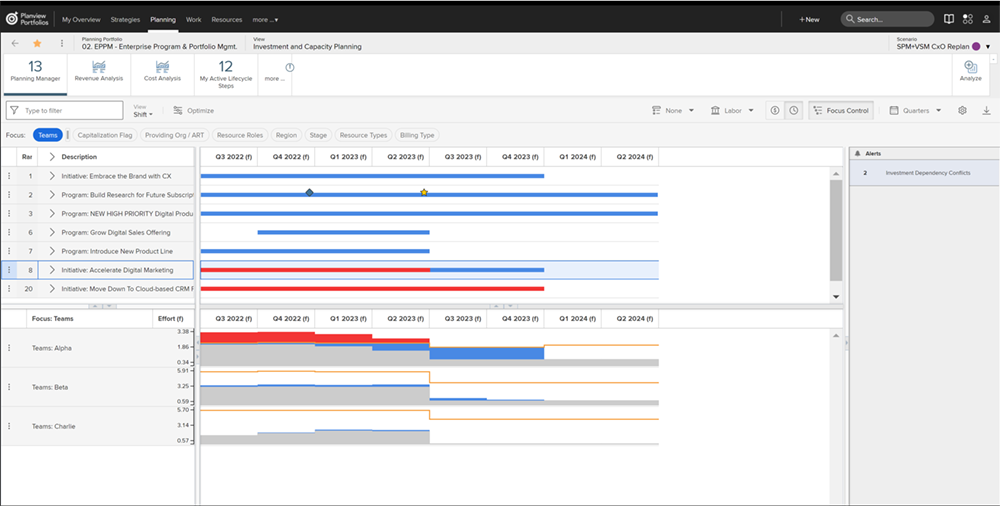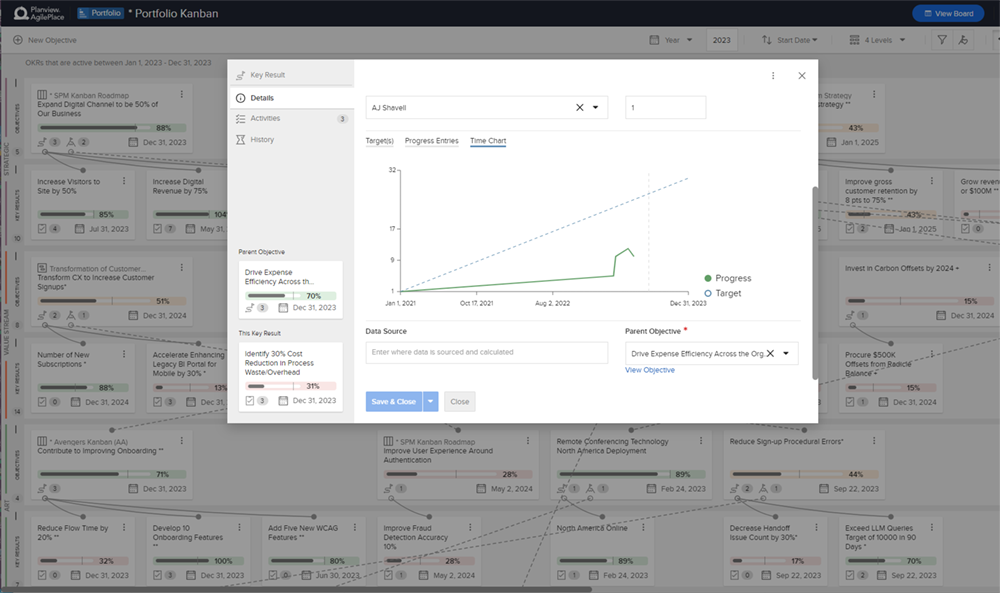Table of contents
- 1Strategic vs. Tactical Planning: Understanding the Differences
- 2Developing a New Strategic Planning Process
- 3Strategic Innovation and Why It’s Important
- 4Start Fresh with a New IT Roadmap
- 5Strategic Planning Software: Moving Beyond Spreadsheets
- 6Strategic Planning: How to Build a Roadmap to Transformation
- 7Strategic Management as Usual Is Inadequate Today
- 8IT Strategic Planning: Managing Change in the Realm of Digital Transformation
Strategic and tactical planning both serve a critical purpose in business settings, but what’s the difference when you compare strategic vs. tactical planning?
The 4 Elements of a Strategic Plan: Avoid Wishful Thinking and Drive Transformation During Economic Uncertainty
Get the most out of your investments with a strategic plan that empowers your enterprise during economic uncertainty.
Read the whitepaper • The 4 Elements of a Strategic Plan2024 Gartner® Magic Quadrant™ for Strategic Portfolio Management: Planview is Named a Leader
Read the report • 2024 Gartner® Magic Quadrant™ for Strategic Portfolio ManagementA strategic plan moves organizations closer to larger goals and objectives. It provides clear direction across the enterprise.
Tactical planning ensures the strategic plan is properly carried out.
To achieve the best results from your plans, you must first understand what a strategic plan is – and, more importantly, what it isn’t.
This article looks at strategic vs. tactical planning. Understand their differences and how to effectively use both within your organization.
That way, you can create well-balanced plans that draw upon both strategic and tactical planning. Plans that ensure your enterprise is well-equipped to further growth, align teams, and maintain competitiveness in a changing professional landscape.

Strategic vs. Tactical Planning: What’s the Difference?
While it’s easy to assume that strategic and tactical planning are at odds, in reality, they work together toward a common goal. Here’s how.
Strategy defines your organization’s long-term goals. Through strategic planning, your enterprise can reach those goals.
Conversely, tactics are more concrete and oriented toward a shorter time frame and smaller steps. This may include best practices, specific plans, resources, and more.
Simply put, strategy refers to the long-term goals that businesses want to achieve. Tactics are the actions taken to achieve those goals.
What is strategic planning?
When looking at strategic vs. tactical planning, keep in mind that your strategy is centered around the long-term goals your business wants to achieve. It focuses on the bigger picture, looking at enterprise objectives and how those goals will be achieved. Strategic plans are usually planned across the entire organization around its vision or mission, and they’re used to help identify growth and development opportunities.
As you’re looking at strategic vs. tactical planning, consider the following:
Strategic planning is proactive and focuses on the “why” of achieving a goal. It considers potential future changes in business environments and how to move beyond them.
This is accomplished by taking a holistic view of the organization and considering factors such as changing customer needs, market trends, and competitors – both current and future.
For example, a strategic plan designed to enhance business competitiveness may include one or more of the following elements:
- Identifying and executing ways to enter new markets
- Diversifying products or services
- Using new technologies to maintain competitiveness
A truly effective strategic plan is also revisited and updated throughout the year.
Continuous review ensures your strategic plan still aligns with the industry’s current state, including technology disruption, economic headwinds, and changing customer demands.
What is tactical planning?
We looked at the basics of strategic planning, but what about its counterpart?
While strategic planning looks at long-term goals and objectives, tactical planning focuses on the short-term – day-to-day actions necessary to achieve the goals laid out in the strategic plan. The approach involves creating detailed timelines, assigning resources, and outlining specific steps. It’s more focused on how the strategic plan will be executed.
Tactical planning is usually reactive. It responds to immediate changes within an industry or business environment, is centered around a known end goal, and needs to be executed quickly and efficiently.
One of the key differences when comparing strategic vs. tactical planning is that strategic planning looks ahead to the future, whereas tactical focuses on the present.
For example, a tactical plan may be created after a sudden shift in customer demand to help the organization quickly adapt to changing market conditions.
You want to use tactical planning when breaking strategic objectives into smaller parts, focusing on the day-to-day actions to achieve those objectives. Typically, managers or leaders will need to revisit these plans more often due to its short-term nature.
To summarize, strategic planning:
- Supports long-term goals
- Are broad, general ideas
- Is big-picture thinking
Tactical planning:
- Supports short-term goals
- Focuses on specific actions
- Involves detailed deliverables
Now that we compared strategic vs. tactical planning, let’s look at how you can use both to execute on strategy.
Getting the Most from Your Strategic and Tactical Plans
For your organization to get the most from both forms of planning, you should follow the best practices listed below.
Effective strategic planning
More often than not, the strategy reflects the mission and vision of an organization. And the strategic plan intends to deliver value to the organization by focusing on goals the enterprise identifies as important to achieve.
Your strategy should be actionable and remain focused on the goal you’re looking to achieve.
An effective strategic plan gathers input from across the organization to ensure there’s alignment between the enterprise’s overarching strategy and each department’s priorities. This is why we shouldn’t look at strategic vs. tactical planning as competing concepts but as two sides of the same coin.

Effective tactical planning
A strong tactical approach should have a well-defined, clear purpose that aids your strategy. It should include a detailed timeline for completing specific activities, how those impacts will be measured, and the resources needed to complete the tasks.
The execution of these tasks should be carefully planned and include timelines and who is responsible for the work. Now, let’s talk about the benefits of strategic vs. tactical planning.
Benefits of Strategic Planning
The most significant benefit of strategic planning is that it enables organizations to proactively prepare for and address problems that arise and position the enterprise in an advantageous position.
This long-term view also empowers organizations to:
- Move your organization from reactive to proactive: Having strategic plans in place enables your organization to anticipate things that may happen and plan accordingly. This also helps your organization to take necessary precautions to avoid unfavorable scenarios. In the event disruptions do occur, your business is more prepared to handle them
- Create clear direction and alignment around enterprise objectives and goals: A strategic plan provides the entire organization with something to work toward. It enables leaders to appropriately allocate resources and make effective business decisions. Using both strategic and tactical planning further aligns teams and provides employees with both a long- and short-term vision
- Implement stronger decision-making: Strategic plans can be used to back or enhance decision-making by using data and diverse points of view captured as teams work toward completing strategic goals
- Measure and improve performance: Providing employees with a purpose or goal to achieve can help increase satisfaction and retention. By regularly checking on goal progress, employees can clearly see how their performance is furthering progress or where more effort is needed
- Manage expectations and bolster employee trust: Strategic plans increase organizational transparency. This helps to improve trust among employees and eliminate ambiguity
What about the other side of the strategic vs. tactical planning coin?
Benefits of Tactical Planning
A tactical plan supports the execution of strategic planning throughout the entire organization. It helps to align teams, increase cross-team collaboration and communication, and boost employee engagement. Additional benefits to tactical planning include:
- Making it easier to reach business goals: Achieve strategic goals by translating the bigger picture into several specific, smaller goals. This ensures everyone knows who is doing what and when it needs to be completed
- Boosting employee engagement and performance: When used together, strategic and tactical planning provide employees with a clear understanding of roles and responsibilities. This helps employees feel more engaged and motivated to do their best work
- Focusing team efforts: Most tactical plans must be completed as quickly as possible. A clear tactical plan keeps teams focused on completing goals and objectives that support the company’s mission and vision
- Promoting transparency: If there’s any uncertainty about who’s doing what, your strategic plan is unlikely to succeed. Implementing tactical plans encourages employees to be organized and ready
- Creating tangible goals: High-level goals can feel daunting to employees; tactical planning makes these goals more digestible and actionable. With a concrete plan in place, teams have a clear path forward and know exactly which actions to take to realize strategic goals
Examples of Strategic and Tactical Outcomes
Consider the examples below to better understand the differences between strategic vs. tactical planning and when to use them.
Examples of strategic planning outcomes:
- By the end of the year, we want to have 40 percent more clients than last year
- Revamp current marketing strategy and increase leads by 50 percent from last year
- Increase client satisfaction rate by 60 percent by the end of the year
Examples of tactical planning outcomes:
- Increase the number of sales by 10 percent each month
- Acquire 25 more leads over the next two weeks and build a new email list with 30 new client emails
- Attend 3 to 4 enterprise networking events to build connections and expand the business network
When the organization sets their strategic plan, they identify goals and determine how they’re going to measure success. This could include setting strategic Objectives and Key Results (OKRs) to:
- Identify where they want the company to go over a certain period of time
- Look at where the company is currently positioned
- Measure success as teams work towards their strategic goals
The tactical plan is how teams break up work to achieve those big-picture, strategic goals. Therefore, tactical planning outcomes make up pieces of a greater strategic puzzle.

Want to learn more about the importance of OKRs and how they bridge the gaps between your strategic and tactical plans? Access this eBook titled “Connecting the Dots Between Strategy and Delivery.”
How to Create a Strategic Plan
Carefully looking at strategic vs. tactical planning enables you to meet your business goals.
Creating a strategic plan is the first step in goal setting. Here’s how to create a well-thought-out plan.
Consider general objectives
The first step in creating a strategic plan is considering your general business objectives, such as boosting revenue, increasing sales leads, or maintaining a competitive advantage. From here, you’ll want to refine the direction of the plan and then set long-term goals. Ensure you’re keeping the company mission in mind as you set those goals.
Evaluate current company position
Once you’ve defined your long-term goals, look at your company’s current state.
- What are your strengths?
- What are your weaknesses?
- Where are your biggest opportunities?
- What are your biggest threats?
All of this should be backed by data, as this will help you build a strong long-term vision and will help you determine what is most influential to your business’ success.
Define success and metrics
Finally, you’ll want to determine what success looks like and how you will measure progress. Remember to include how often you’re going to measure progress; it shouldn’t be too often – ideally once per quarter – to assess the health of your current plan.
Once your plan has been created, share it across the enterprise to drive alignment between strategy and execution.
How to Create a Tactical Plan
The purpose of a tactical plan should be to further your enterprise strategy. That’s why strategic vs. tactical planning are both important and should never be looked at as an either-or scenario.
Your tactical plan breaks long-term goals down into smaller tasks that can be completed in a few days or weeks. As you’re creating a tactical plan, keep the following in mind.
Focus on short-term goals
Focus team efforts on goals that can be achieved in a shorter period of time (i.e., a few weeks to a few months). You also want to make sure these plans help reach strategic goals.
To do so, divide the long-term goal into smaller, time-bound steps, then look at what you can achieve in that time. Think about where you want to be at the end of each sprint or at the end of the month.
Look at the smaller details
Get granular.
You already know you need to create smaller goals that help you achieve your bigger strategic goal. You also want to consider and plan out the specific actions needed to reach each of those smaller goals.
Consider the amount of time needed to reach each goal as well as the skills and resources each tactical plan requires.
Assemble your teams
With goals and a timeline in place, it’s time to assemble your teams to do the work. Cross-functional teams composed of members with various skills work great in this type of scenario, as this ensures diversity among experience and skillsets.
Measure progress frequently
How often you measure progress will vary depending on the task at hand. In some situations, it may make sense to measure progress daily; other times, you may need to check in weekly, bi-weekly, or even monthly.
Just make sure that you do measure progress to address bottlenecks and ensure your strategic and tactical plans stay aligned, increase visibility, and keep everyone accountable.
Strategic vs. Tactical Planning: Getting the Most from Both
Strategic and tactical planning both play a critical role in enabling your business to reach short- and long-term goals.
While strategic goals provide a clear, big-picture plan, the tactical counterpart provides the steps to achieving those strategic goals. Together, a strategic and tactical plan help ensure the success of your enterprise for years to come. How do you create a strategic plan that drives your enterprise forward during times of fast-paced change? By avoiding wishful thinking.
Download the whitepaper, “The 4 Elements of a Strategic Plan” and discover how to build a plan with confidence.
